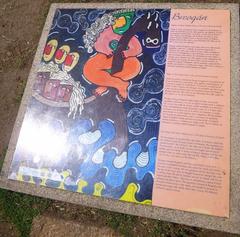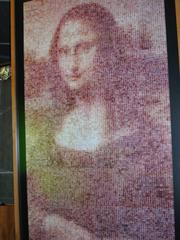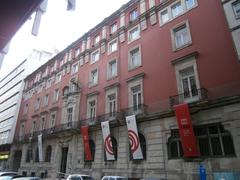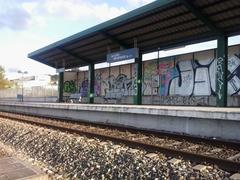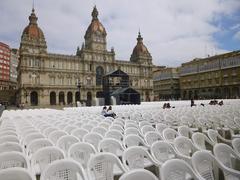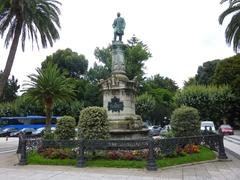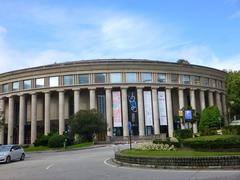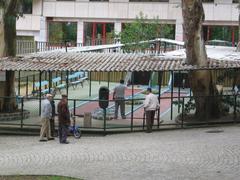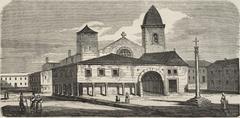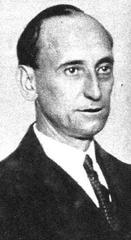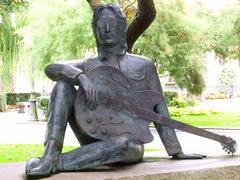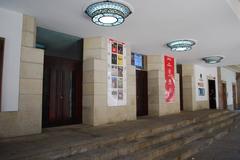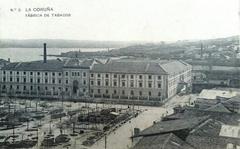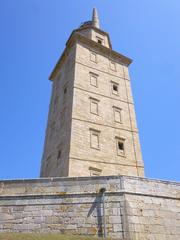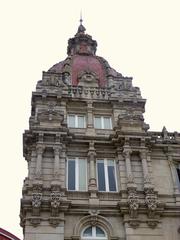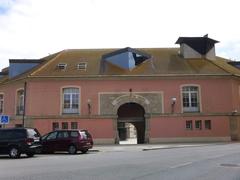
Port of A Coruña Visiting Hours, Tickets, and Travel Guide
Date: 03/07/2025
Introduction to the Port of A Coruña
Nestled on the northwestern Atlantic coast of Spain, the Port of A Coruña is a historic and vibrant maritime gateway that has shaped the city’s identity for centuries. Serving as a bridge between ancient Celtic roots and modern commerce, the port sits at the heart of A Coruña, Galicia, and is renowned for its blend of maritime activity, cultural landmarks, and accessible urban waterfront.
The port’s strategic position has contributed to its significance from pre-Roman settlements through the Roman era—exemplified by the still-operational Tower of Hercules lighthouse—through to Spain’s Age of Exploration and into the present as a major center for shipping, fishing, and cruise tourism. With its close proximity to the city center, visitors enjoy seamless access to historic promenades, cultural venues, lively markets, and beautiful beaches such as Riazor and Orzán.
This comprehensive guide provides essential information on visiting hours, ticketing, accessibility, transportation, and nearby attractions, ensuring travelers can make the most of their visit to this dynamic port city. For up-to-date details, travelers are encouraged to consult the official Port of A Coruña website, the A Coruña Official Tourism site, and the interactive Audiala app.
Table of Contents
- Overview and Historical Significance
- Practical Visitor Information
- Port Facilities and Infrastructure
- Top Attractions Near the Port
- Practical Tips and FAQs
- Suggested Itineraries and Contacts
- Sustainability and Future Developments
- Summary and Recommendations
- Sources
1. Overview and Historical Significance
Ancient and Roman Foundations
The origins of A Coruña’s port trace back to the Artabri, a Celtic tribe who established settlements in the area as early as the 3rd century BCE. The Romans recognized the site’s strategic value, naming it Portus Magnus Artabrorum, and developed it into a significant trading hub. Their legacy endures in the Tower of Hercules, a UNESCO World Heritage Site and the oldest Roman lighthouse still in operation (Nomads Travel Guide; Wikipedia: History of A Coruña).
Medieval Growth and Maritime Expansion
After the fall of Rome, A Coruña weathered invasions and became a prominent medieval town under the Kingdoms of Asturias and Galicia. King Alfonso IX of León granted the city its first charter in the 12th century, fostering economic growth and the expansion of fishing and textile industries. By the 15th century, free commerce with England further strengthened the port’s international ties (TourSpain).
Age of Exploration and Military Significance
The 16th century saw the port serve as a launching point for Spanish expeditions and as the site of historic events, including the city’s defense against Sir Francis Drake’s attack in 1589—a feat commemorated in María Pita Square. The port also served as the political capital of the Kingdom of Galicia during this era (Nomads Travel Guide).
Industrialization and Modernization
The 19th and 20th centuries ushered in modernization, with the port’s infrastructure expanding to meet the needs of a growing city and evolving industries. The arrival of the Universidade da Coruña in 1989 marked a new era of innovation and economic vitality (Nomads Travel Guide).
Contemporary Role and Urban Integration
Today, the Port of A Coruña is a multifaceted hub for cargo, fishing, and cruise tourism. It covers 1.15 km² of land and nearly 10 km² of water, featuring both historic docks and a modern outer port. Recent urban integration projects have opened up port spaces for public enjoyment, cultural events, and leisure, strengthening the city’s connection to its maritime heritage (Puerto de A Coruña; Wikipedia: Port of A Coruña).
2. Practical Visitor Information
Visiting Hours
- Public Waterfront and Promenades: Open year-round, generally accessible 24/7.
- Key Attractions:
- Tower of Hercules: Daily, 10:00–19:00 (April–October); shorter hours in winter.
- Castillo de San Antón: Typically 10:00–18:00, closed Mondays.
- Museums and Markets: Hours vary; check individual sites.
Tickets and Admission
- Port Area & Promenades: Free access.
- Tower of Hercules: ~€3–€5/adult; discounts for seniors, students, and children.
- Castillo de San Antón: ~€2/adult; discounts available.
- Guided Tours and Museums: Fees and reservations may apply; book in advance during peak seasons.
Getting There and Accessibility
- By Foot: The port is adjacent to the city center and most major sights are within 10–20 minutes’ walk.
- Public Transport:
- City buses (lines 1, 1A, 2, 3, 3A, 5, etc.) stop near the port.
- Main train station is 2.5 km away, offering connections to Santiago de Compostela, Madrid, and beyond (RENFE).
- Taxi and Parking: Taxis are readily available; parking is limited around the port.
- Accessibility: Most public areas and attractions are wheelchair accessible. Some historic streets have cobblestones but main venues offer adapted access.
3. Port Facilities and Infrastructure
- Cargo Operations: Spain’s top port for fresh fish landings; major bulk cargo and hydrocarbons hub (PortSEurope).
- Cruise Services: Transatlantic and Calvo Sotelo quays serve cruise ships; terminals offer tourist info, Wi-Fi, and direct city access (CruiseMapper).
- Fishing and Markets: Local seafood markets and eateries are integral to the port’s daily life and visitor experience.
- Urban Integration: Projects like Coruña Marítima open waterfront spaces for leisure, events, and recreation (PortSEurope).
4. Top Attractions Near the Port
María Pita Square (Praza de María Pita)
- What: Civic heart of the city, with a monument to the local heroine.
- Hours: Open 24/7.
- Tickets: Free.
- Tips: Great for coffee and people-watching (Brogan Abroad).
Old Town (Ciudad Vieja)
- Highlights: Romanesque and Baroque churches, San Carlos Garden, medieval streets.
- Tours: Guided walks available for deeper historical insights (Virgin Voyages).
Tower of Hercules (Torre de Hércules)
- What: UNESCO-listed Roman lighthouse.
- Hours: 10:00–18:00.
- Tickets: ~€3/adult.
- Getting There: 2.5 km from port; walk or take city bus.
- Experience: Climb for panoramic views and visit the Sculpture Park (WhatsInPort).
Castillo de San Antón
- What: 16th-century fortress and archaeology museum.
- Hours: 10:00–18:00, closed Mondays.
- Tickets: ~€2/adult.
- Tips: 15-minute walk from port, offers sweeping views (Galicia Travels).
Aquarium Finisterrae
- What: Atlantic marine aquarium with interactive exhibits.
- Hours: 10:00–19:00.
- Tickets: €10 adults, €4 children (Audiala).
Riazor and Orzán Beaches
- What: Urban beaches for relaxation and water sports.
- Access: 10–15 minutes’ walk from port (WhatsInPort).
Paseo Marítimo
- What: 13 km scenic coastal promenade.
- Activities: Walking, cycling, photography (Cruise-Port.com).
Mercado de San Agustín and Plaza de Lugo Market
- What: Lively markets with fresh Galician produce.
- Hours: 8:00–15:00 (Virgin Voyages).
Museo de Belas Artes da Coruña
- What: Museum of Spanish and Galician art.
- Hours: Tue–Sun, 10:00–20:00.
- Tickets: Free (Audiala).
MEGA Mundo Estrella Galicia
- What: Brewery and beer museum.
- Tours: Guided tastings available; booking recommended (Virgin Voyages).
5. Practical Tips and FAQs
Practical Tips
- Most attractions are within 15–20 minutes’ walk from the port.
- Consider online or advance ticket purchases, especially during cruise season.
- Free Wi-Fi is available at Los Cantones Village and the cruise terminal.
- Shops may close for siesta (13:30–16:00); most museums close Mondays.
- Pack for mild, often rainy weather; comfortable shoes are recommended.
- Local cuisine is seafood-driven—try pulpo a la gallega and local empanadas.
Frequently Asked Questions
Q: What are the visiting hours for the Tower of Hercules?
A: Daily, 10:00–18:00 (April–October); consult official site for winter hours.
Q: Do I need tickets for main attractions?
A: Most public spaces are free. Tickets are required for the Tower of Hercules, Castillo de San Antón, and guided tours.
Q: Is A Coruña accessible?
A: Most attractions and the port are accessible; some old streets have cobblestones.
Q: How do I get to the city center?
A: The port is adjacent; downtown and major sites are within easy walking distance.
Q: Are guided tours available?
A: Yes, book via tourist offices or online for walking or bus tours.
6. Suggested Itineraries and Contacts
Half-Day Walking Tour
- Stroll Avenida Marina for glass balconies (galerías).
- Visit María Pita Square.
- Explore Ciudad Vieja’s medieval streets.
- Head to Riazor Beach or climb the Tower of Hercules.
Full-Day Excursion
- Morning: Old Town, María Pita Square, and local market.
- Afternoon: Tower of Hercules and Sculpture Park.
- Evening: Tapas in the port area.
Useful Contacts
- Port Address: Avda. de la Marina, 3, 15001 La Coruña, Galicia
- Tourist Info: At port and city center (A Coruña Official Tourism)
- Train Schedules: RENFE
- Weather: Spain.info
7. Sustainability and Future Developments
The port authority invests in green logistics, renewable energy, and innovative surveillance, with ongoing projects to reduce urban pollution by relocating bulk and hydrocarbon operations to the outer port. The Coruña Marítima initiative continues to transform the seafront into a vibrant public and cultural space (PortSEurope).
8. Summary and Visitor Recommendations
The Port of A Coruña exemplifies the harmonious fusion of centuries-old maritime heritage and modern city life. Its central location offers easy access to key sites, lively markets, and scenic promenades. With abundant visitor amenities, accessible infrastructure, and a full calendar of cultural events, it stands out as a must-visit on Spain’s Atlantic coast.
To ensure a smooth and enriching visit:
- Check the official port website and tourism portal for real-time updates.
- Download the Audiala app for interactive maps, digital tours, and personalized recommendations.
- Plan ahead for museum hours, guided tours, and local events.
Explore A Coruña’s port to experience the intersection of history, culture, and the sea.
9. Sources and Further Information
- Nomads Travel Guide
- Wikipedia: History of A Coruña
- TourSpain
- Puerto de A Coruña Official Website
- PortSEurope
- CruiseMapper
- Spain.info
- Audiala
- Cruise Crocodile
- Virgin Voyages
- Galicia Travels









